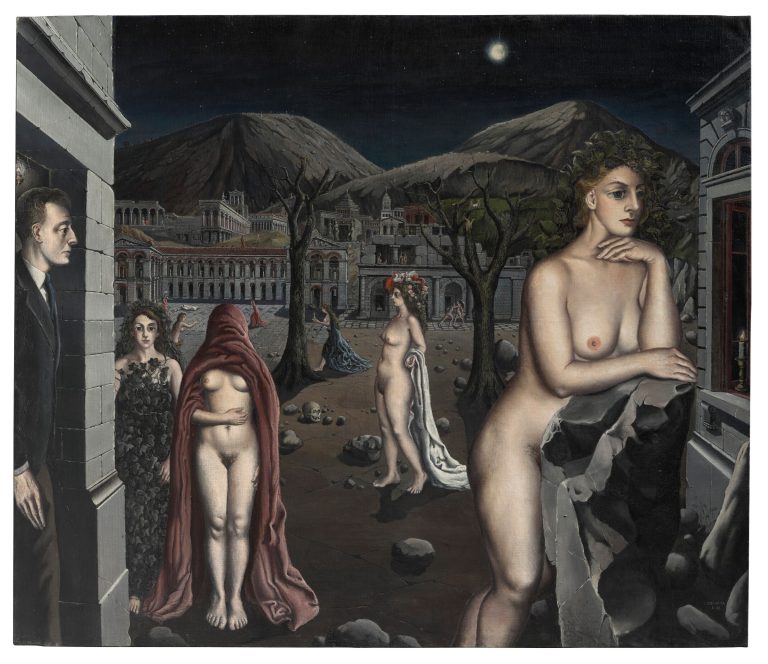[ad_1]
A version of this article originally appeared in The Back Room, our lively recap funneling only the week’s must-know art industry intel into a nimble read you’ll actually enjoy. Artnet News Pro members get exclusive access—subscribe now to receive the newsletter in your inbox every Friday.
Though the sun was out all week in London during the first marquee auctions of the year, a chill in the market persists. Here are the top takeaways. (Keep your jacket on.)
Size Matters
Christie’s more than doubled its rival Sotheby’s total across its evening sales. Sotheby’s had a much smaller offering, and some have speculated that it struggled to win material, despite its U-turn on its unpopular fees restructure earlier this year. Christie’s back-to-back 20th-/21st-century and Surrealist art auctions on Wednesday totaled £130.1 million (about $166.6 million) across 72 lots, while Sotheby’s 38-lot sale netted £62.5 million ($78.6 million) the previous night. Both houses’ totals fell comfortably within their presale estimates. (Nota bene: results include fees, estimates do not.)
Phillips, for its part, brought in £15.4 million ($19.8 million) across 29 lots, although that total was still below the house’s £16.3 million ($21.1 million) presale low estimate. It is, at least, a slight improvement from the same sale last year, which brought in £13.7 million ($17.4 million), also across 29 lots.
Auctioneer Henry Highly sells the top lot of Phillips London evening sale, Joan Mitchell’s Canada II (1975), which went for $3.49 million.
Christie’s and Sotheby’s both put up fewer works than last year, suggesting that people remain hesitant to sell amid the market’s contraction. Last year’s 20th-/21st-century sale at Christie’s brought in a slightly higher total, £137.7 million ($174.8 million) though 87 works were offered, compared to this year’s 51—a remarkable 41-percent drop. Sotheby’s equivalent sale last year was roughly 40 percent larger and earned far more for the house, £99.7 million ($126.5 million).
New Works Were Scarce
This year, Sotheby’s declined to stage its “The Now” sale, which is dedicated to ultra-contemporary works, as part of the festivities. There were few ultra-contemporary pieces (by artists born after 1974) across the auction houses.
Christie’s peppered its evening sale with a couple newer works, such as a 2021 Danielle McKinney and a 2023 Justin Caguiat. They sold well above their estimates, and according to art advisor Liberte Nuti, drew 10 to 15 bidders. However, the bidding was thin on several blue-chip lots, including a Francis Bacon and an Amedeo Modigliani. Overall, she said the sales “were well curated and took only measured risk.”
The reduction in newer works by younger artists reflects the cautious market. Amid the economic uncertainty of the past two years, sales in the ultra-contemporary category have fallen more than those in any other age bracket, as collectors move toward artists with more proven markets. According to the Artnet Price Database, ultra-contemporary sales at auction shrank by 37.9 percent between 2023 and 2024. The same category contracted by 25.1 percent between 2022 and 2023.

René Magritte La reconnaissance infinie sold for £10 million ($13.3 million) at Christie’s. Photo: Wiktor Szymanowicz/ Anadolu via Getty Images.
Surrealism Reigns Supreme
The global appetite for Surrealist works has yet to be sated, which benefited Christie’s. Its “Art of the Surreal” auction had 25 lots, the same as last year, and appeared to have the best run of the week. As my colleague Vivienne Chow noted, only one lot failed, and the sale yielded a hammer total of £39.4 million ($50.8 million), above its fees-free presale high estimate. The total after fees was £48 million ($61.5 million), with a sell-through rate of 96 percent.
René Magritte’s 1933 La reconnaissance infinie was the priciest lot of the week, at £10 million ($13.3 million). But the real standout was a group of three Paul Delvaux paintings, which all sold well above their presale estimates—a feat for an artist’s market that Nuti said had previously been considered “niche.” The stunning La ville endormie (1938) sold for £6.2 million ($7.96 million) after fees, more than three times its high estimate and the second-highest auction price for the artist, according to Artnet’s data.
Another highlight from the week was Yoshitomo Nara’s literally glittering 2005 canvas Cosmic Eyes (In the Milky Lake), which led Sotheby’s Tuesday evening sale, fetching £9.03 million ($11.4 million). The same night, a 2005 Banksy painting exceeded its presale estimate, selling for £4.3 million ($5.5 million). Consigned by Blink-182 frontman Mark Hoppus, it riffs on The Singing Butler (1991) by Scottish artist Jack Vettriano, who died last week at 73.

Yoshitomo Nara, Cosmic Eyes (In The Milky Lake), 2005. Courtesy of Sotheby’s.
Meanwhile, an Egon Schiele drawing that was stolen by the Nazis from Austrian Jewish cabaret performer Fritz Grünbaum went for over £3.3 million ($4.2 million) at Christie’s, soaring past presale expectations. Separate from the evening sales, the house’s controversial all-A.I. auction blew by its presale estimate, bringing in $728,784.
Despite those bright spots, the market has yet to warm up. Geopolitical tensions remain high, especially as President Trump’s trade wars rattle even the U.S.’s closest trading partners, and global inflation has been slow to decline. Meanwhile, the U.K. art market remains embattled by a confluence of factors, including Brexit-born bureaucracy, a potential wealth drain from people departing for more hospitable tax regimes, and an increasingly competitive auction calendar, with the major houses recently launching new salerooms in Paris and Hong Kong. Fine-art auction sales in the U.K. were at their lowest level in a decade in 2024, according to the Artnet Price Database,and this week’s sales did not do anything to raise the market’s temperature.
[ad_2]
Source link


